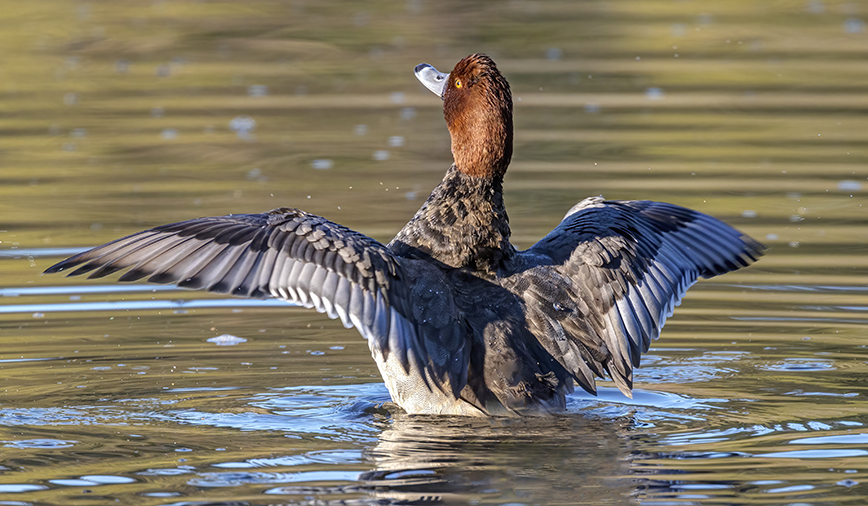I don’t know how you spent your Friday morning, but I spent mine stalking redheads.
No, I wasn’t camped out in front of Conan O’Brien’s place, nor was I trying to catch a glimpse of the little bit of red Ron Howard has left. Nope, I was lurking along the banks of the Fox River at Pottawatomie Park, lying in wait for my favorite redhead of all, Aythya americana. That is, the redhead duck.
Redheads are named for the distinctive coloration of the male, whose head is the color of Audrey Hepburn’s hair (minus the highlights) in Breakfast at Tiffany’s. Other distinguishing characteristics are yellow eyes, a blue bill with a black tip, and grayish body and wings. These features help distinguish redheads from the canvasback, another species with males that have reddish heads. The canvasback hue, though, is darker, more like Judy Garland’s Wizard of Oz ‘do.
But what makes redheads—the ducks—so fascinating to me is the one-two punch of a) their relative rarity in our area and b) their curious approach to reproduction.
Redheads typically show up in our area as the cold weather is waning. They are a species that overwinters across the southern United States and breeds primarily in the prairie pothole region of the upper Midwest. A few individuals use the Fox River Valley as a stopover on their north by northwest journey, and seeing them is a sure sign that spring is on its way.
I saw a male and two females paddling along the river on Tuesday, and that got me into redhead mode. It also got me thinking about what lies ahead for them. They have miles to go, and they—the females, anyway—have some decisions to make.
After arriving at the breeding grounds, momma redhead (who, by the way, is mostly brown, with a bluish bill) will size up the situation. What is the condition of the cover, or the grasses and rushes in which she will make her home? How much food is available? How are the neighbors? She’ll also take stock of her own qualities, namely her age and whether her fat reserves are in good shape. (Being able to pinch an inch is a good thing, when you’re a duck in breeding season.)
After assessing the situation, she will proceed with one of several breeding strategies. If food and cover are plentiful, she may go ahead and make her own nest, lay her own eggs, incubate them and then raise her own young. But if any of those requirements are lacking, she likely will alter her approach and either lay some eggs in her own nest and some at the neighbors; lay all of her eggs in neighboring nests; or lay no eggs at all.
That last option is the least attractive, since the name of the game is passing genes along. But some of those other alternatives—known as brood parasitism—make redheads fascinating indeed.
It’s not so much that they may decide to drop eggs in other ducks’ nests—actually many duck species do that, including wood ducks, goldeneyes, buffleheads, mergansers and ruddy ducks. But these species are intraspecific brood parasites—they seek out nests made by members of their own species.
Redheads, however, are unique in that they are highly adaptive. They will lay eggs in other redhead nests, as well as the nests of other species—especially canvasbacks, but also mallards, scaups, gadwalls…basically, whomever’s home that might be handy.
Typically, Mom Redhead will until a nest is unattended, then waddle over and drop her future duckling off. But sometimes female redheads will take a more forceful approach, pushing their way in, and under, another nesting female. With the resident female dislodged, the redhead becomes queen of the hill, at least for a few minutes. Which, as it turns out, is all the time she needs to lay an egg, then leave.
If you’re as into redheads as I am, now is the time to get out and see them. The quiet water by Pottawatomie is a good spot, as is the stretch of river south of the Prairie Street bridge in St. Charles. I’m sure there are lots of other good spots too. Look for areas where waterfowl gather, then look closely at each bird; species tend to mingle at this time of year.
Just be sure to practice appropriate protocol. As a migratory species, redheads are a little more wary than our ubiquitous mallards and Canada geese. Nothing’s more frustrating than having your quarry fly away before you barely catch sight of it. Move slowly and quietly, and chances are good you’ll be rewarded with a look at a handsome redhead.
Pam Otto is the manager of nature programs and interpretive services for the St. Charles Park District. She can be reached at potto@stcparks.org or 630-513-4346.

